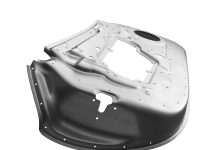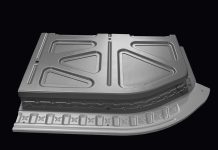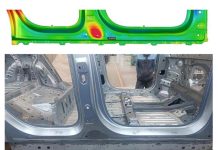Engineering work increasingly relies on simulation results to avoid unexpected problems and achieve planned performance prior to building costly prototypes or starting production. Proper virtual analysis can lead to cost reductions and ensure launch dates are met.
However, when structural engineers lack experience in the manufacturing process of individual components, the transformation of materials during manufacturing can seem like a black box that should be avoided. As a result, an average of material properties listed on the steel standard is often used to build structural analysis models, along with a constant material thickness (as shown in Figure 1).
![]()
Figure 1. The “black box” of material transformation in the manufacturing stage
Nowadays, virtual analysis for automotive production can begin right from the start, at the raw material production stage. Each hydro-forming process is unique and specifically engineered for each component. The most common stages are shown in Figure 2.
![]()
Figure 2. Primary stages in a hydro-forming process
The raw material for straight tubes is typically a steel coil, as shown in the schematic process in Figure 3 sourced from Nippon Steel’s website (nipponsteel.com). Fortunately, there are several Finite Element Analysis codes (FEA) that can simulate each of the process steps presented in Figure 3.
![]()
Figure 3. Schematic process steps to produce steel coils (source: nipponsteel.com)
If one of the objectives of steel coil manufacturing is to achieve homogeneous material properties along the coil, then it may be possible to skip the coil manufacturing simulation and start the hydro-forming process validation afresh by conducting tensile testing on the steel upon its arrival at the warehouse.
Based on the results of the tensile test, the mechanical properties of the steel, including the strain-stress curve, yield surface, and an estimation of the Forming Limit Curve (FLC), can be determined. This information can then be introduced into our material generator to create the material card for the steel, which can be used to start the manufacturing process from the coil. Figure 4 depicts the steps to determine the material properties and map them onto the material mesh for the hydro-forming simulation.
![]()
Figure 4. Steps to determine and map material properties onto a mesh
The first step in the hydro-forming process is the manufacture of the straight tube from a steel coil. Roll forming is the most convenient process for tube manufacturing (as shown in Figure 5), although extruded tubes are also an option. However, after this first step, the material properties are no longer homogeneous along the thickness due to the bending process involved in roll forming.
![]()
Figure 5. Roll-forming flower and production line. Source: thefabricator.com
The material properties remain unchanged on the middle layer of the thickness, maintaining the same yield point even after the tube manufacturing process. However, changes in material properties are observed along the tube thickness, as shown in Figure 6, which were estimated using our tube forming software. The inner layer of the tube undergoes compression strains, while the outer layer experiences stretching strains. The neutral fiber is the layer where the material properties do not change, and its height with respect to the inner radius varies based on the relationship between the inner bending radius and the tube wall thickness. If the bending relationship is less than 4, the neutral fiber is closer to the inner radius, whereas it remains at the middle of the thickness if the relationship is greater than 4.
![]()
Figure 6. Yield point at different layer of a tube made out of DX53D
The subsequent stages of the hydro-forming process require localized deformation at specific locations on the tube to achieve the desired component geometry. Figure 7 illustrates the calculated concentrations of deformations. As a result of the induced deformations, the material properties along the component are no longer homogeneous and depend on the severity of the deformation.
![]()
Figure 7. Required localized deformations in a hydro-forming process
The non-homogeneous material properties along the hydro-formed component can result in weak correlation results in structural analysis when it is modeled based on the CAD geometry, constant thickness, and material properties taken from the steel standard, as shown in Figure 1. This practice does not take into account the manufacturing history of each component in the assembly, which is common in several industries due to short engineering time or a lack of hydro-forming knowledge.
In our software, we replace the geometry with a discrete number of elements connected via nodal points to form an overall system. This discretization allows for a better estimation of the localized deformations required in a hydro-forming process, providing traceability of the material property changes throughout the manufacturing process. The material properties at the end of each step are considered to start the next one, starting with the material properties of the coil for tube manufacturing, and considering the new material properties of the tube for the bending stage and so on until the last stage, laser cutting.
The final material properties can be shared and exported in the form of FEA code, allowing the final hydro-formed component properties to be considered the starting point for structural analysis. Figure 8 shows a path of material properties that should be considered in a structural analysis.
![]()
Figure 8. Path of material properties for a structural analysis
The following are the final hydro-forming component properties that can be shared through our export:
- The tube mesh, including its different layers
- The final plastic strain for each element
- The final thickness for each element, as shown in Figure 9
![]()
Figure 9. Component mesh with final plastic strain and thickness.
The information can be exported in various formats that are ready to be read by different FEA codes, or in a neutral format with Comma Delimited Values (*.csv), as shown in Figure 10.
![]()
Figure 10. Head of an exported element list with thickness and plastic strain
When analyzing the structural integrity of each element in relation to its final thickness and strength, there is a higher correlation in the analysis results. In the automotive industry, it is common practice to reduce the initial material thickness by 25% for Low Strength Steels (LSS) to reduce manufacturing costs. However, this reduction in thickness can lead to discrepancies in the results. It is important to consider the final component geometry or mesh to detect assembly problems caused by form deviations, including uncompensated manufacturing processes and/or springback. AutoForm-TubeXpert can compensate for springback of the material on the cavity surfaces to save tryout loops and ensure better assembly conditions.
To provide an example of data set exportation from engineering strain-stress curve representation to final new yield point per element, let’s consider the stages of a steel DX53D in a hydro-forming process.
Engineering Strain-Stress Curve Representation
First, the material’s mechanical properties are determined through a standard tensile test. The resulting engineering strain-stress curve is then converted to real values and fitted into a mathematical model (as shown in Fig. 11).
![]()
Figure 11. Mathematical representation of the real strain-stress curve for a DX53D steel
Plastic Strain Per Element
To model the structural analysis, the FEA analyst may require the new yield point of each element. This data can be calculated on a spreadsheet using the mathematical representation of the material together with the final plastic strain, which can be found in column F of Figure 10. The mathematical representation of the material can be converted into formulas that take data from column F to create a new column with the new element’s yield point, as shown in Figure 12.
![]()
Figure 12. Formula to calculate the new element’s yield point in a spreadsheet for a DX53D steel
When selecting the type of strain-stress curve to use as the base for the structural analysis, it is important to consider whether to use engineering or real. The degree of correlation is higher when the real strain-stress curve is considered in the hydro-forming process simulation. Therefore, exported data are related to the real curve. If the structural analysis model is based on the engineering curve, further calculations are required to obtain an equivalent engineering value for each element’s yield point.
It is worth noting that our calculations employ triangular elements with a linear displacement approach, constant strain distribution, and linear element trial function. However, if the FEA software for the structural analysis requires elements with more complex approaches and different element shapes, a mapping process is required to incorporate each group of elements properties from AutoForm into each of the new structural analysis elements.
To Conclude
When manufacturing straight tubes, material properties can change, resulting in weak correlation results if the structural analysis model is based solely on CAD geometry, steel standard properties, constant thickness, and strength. This is because the material properties can change during the manufacturing process. AutoForm addresses this by estimating material property changes during the most common tube and sheet-metal automotive manufacturing processes. The final element properties for each automobile component can then be shared with a third-party FEA code to build a more reliable structural analysis model. Our team is constantly developing solutions for the full digitalization of the manufacturing process, including design, validation, and optimization for cold, hot, and hydro-forming, as well as assembly of tube and sheet-metal parts.













